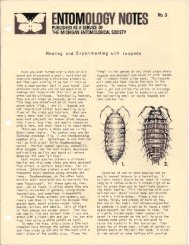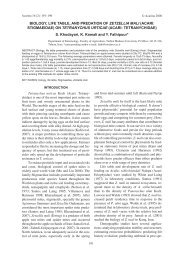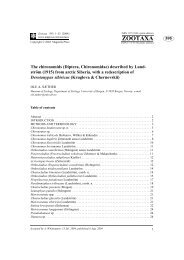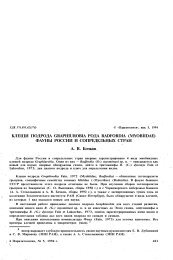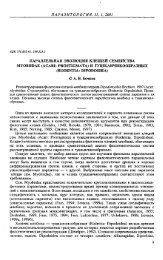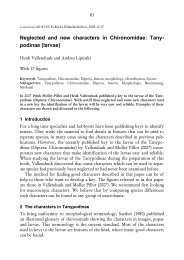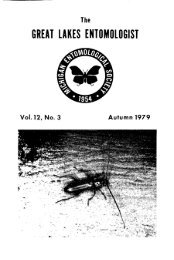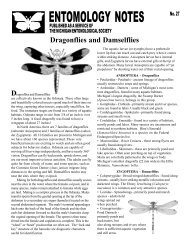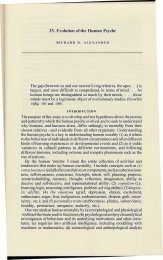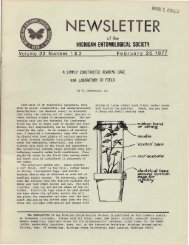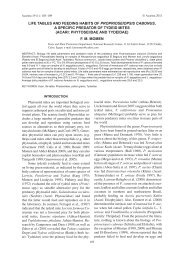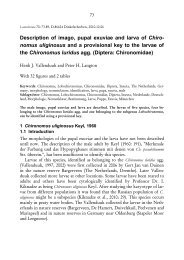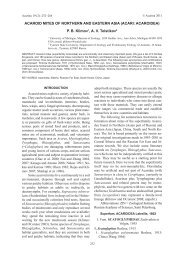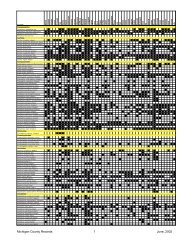Williamsonia 1-1 [v4.0] (DR) - Insect Division - University of Michigan
Williamsonia 1-1 [v4.0] (DR) - Insect Division - University of Michigan
Williamsonia 1-1 [v4.0] (DR) - Insect Division - University of Michigan
You also want an ePaper? Increase the reach of your titles
YUMPU automatically turns print PDFs into web optimized ePapers that Google loves.
<strong>Williamsonia</strong><br />
Issue #1, No. 1 Winter, 1997<br />
Welcome to the MOS!<br />
by Mark O’Brien<br />
This newsletter marks the beginning <strong>of</strong> 1997, and<br />
the second six months <strong>of</strong> the <strong>Michigan</strong> Odonata Survey.<br />
I decided to name the newsletter <strong>Williamsonia</strong> due to the<br />
fact that E.B. Williamson’s collection is the nucleus <strong>of</strong><br />
our Odonata collection at the UMMZ, and also because<br />
the genus bearing his name is a most desirable one,<br />
especially in <strong>Michigan</strong>. The <strong>Michigan</strong> Odonata Survey is<br />
barely six months old as I write this, and I feel that we<br />
have accomplished some goals in a short time.<br />
The past summer was an exciting one for me,<br />
really getting my feet wet (and other body parts) with<br />
Odonata in the field. Mike Kielb and I and shared some<br />
real good collecting days. We were lucky this past<br />
summer to have found some significant records, and the<br />
number <strong>of</strong> new county and state records will likely<br />
increase next season. We have been busy identifying our<br />
catches from the summer, and here is a quick list <strong>of</strong> the<br />
other projects we have going on:<br />
1. Sorting, identification and cataloging <strong>of</strong> the larval<br />
odonate collections by Ethan Bright. (More about this<br />
later in this issue).<br />
2. Cataloging the <strong>Michigan</strong> adults in the UMMZ<br />
Collection. Mike Kielb and I have been entering the<br />
data from the summer 1996 specimens, and we have<br />
only just begun to enter the UMMZspecimens into the<br />
database. As <strong>of</strong> the end <strong>of</strong> December, there are about<br />
1700 specimens catalogued. Of course, we are always<br />
looking for volunteers for this monumental task.<br />
3. Cataloging the UMMZ exuviae collection - a project<br />
undertaken by Alexis Kielb, a student at Ann Arbor<br />
Community High SChool. We inherited the Kennedy<br />
and Williamson collections, but the exuviae were<br />
definitely not well-curated. Most have been locked away<br />
in storage for many years, and as a result the data<br />
(much <strong>of</strong> it valuable) has been unavailable until now.<br />
Alexis is doing a great job getting the collection into a<br />
useful state. About half <strong>of</strong> the exuviae collection is now<br />
catalogued and curated.<br />
We have plans for a spring MOS meeting/workshop,<br />
Published by the <strong>Michigan</strong> Odonata Survey<br />
<strong>Michigan</strong> Odonata Survey -<br />
1st Meeting Highlights<br />
On Sept. 28, the MOS held its first meeting, and 14<br />
Odonata enthusaists attended. Tim Vogt gets the<br />
award for "farthest travelled" as he drove from<br />
Springfield IL. His knowledge and enthusaism were<br />
greatly appreciated by all <strong>of</strong> us. With the exception <strong>of</strong><br />
Tim Vogt and Bob Glotzhober, the attendees were from<br />
SE lower <strong>Michigan</strong>.<br />
Bob Glotzhober <strong>of</strong> the Ohio Dragonfly Survey<br />
shared some <strong>of</strong> his experience from the ODS's<br />
activities. He made some very pertinent suggestions<br />
and observations that we'll try to follow. He also<br />
brought along some copies to sell <strong>of</strong> the very beautiful<br />
Ohio Dragonflies poster. I know that was appreciated<br />
by several <strong>of</strong> us.<br />
By far, the best aspect <strong>of</strong> the meeting was the<br />
sharing <strong>of</strong> ideas and experiences that we have had. I<br />
think everyone took something useful away with them<br />
from the meeting. There were all levels <strong>of</strong> experience<br />
present, from beginners to established experts.<br />
Everyone was able to contribute to the meeting, which<br />
bodes well for the survey. Several items stand out and<br />
some <strong>of</strong> them have already been acted upon:<br />
Specify targeted species, areas and habitats for future<br />
collecting efforts<br />
Use exuviae surveys in places like the MetroParks to<br />
acquaint visitors with Odonata and to survey without<br />
worrying about collecting living insects.<br />
Make changes to the database to accomodate UTM<br />
coordinates, as well as numbering each specimen.<br />
Finish an updated distribution map for each species to be<br />
used by MOS members<br />
Find volunteers to help catalogue specimens in the database<br />
Prepare an MOS member packet to provide as much<br />
information for the participants as possible<br />
Provide an MOS "ID Card" and MOS fact sheet for field<br />
workers<br />
Provide "target species" fact sheets to participants<br />
We all agreed that a late winter-early spring workshop<br />
in 1997 would be a good idea, and we are making plans<br />
to do so. Such a workshop would likely be held in Ann<br />
Arbor, and might include:<br />
•Identification <strong>of</strong> adults using keys<br />
•Larval morphology and keys to identification<br />
•Specimen preparation techniques<br />
continued on page 3
2<br />
Surveying for Odonata in the<br />
Huron Mountains in 1996<br />
by Mark O'Brien<br />
The Huron Mountains region in Marquette County, MI<br />
(about an hour northwest <strong>of</strong> Marquette) is an interesting area<br />
for dragonflies, due to the variety <strong>of</strong> undisturbed stream<br />
systems, lakes, beaver ponds and other wetland areas. I had<br />
made five previous trips to the Huron Mountains from 1984-<br />
94 to work on solitary and social wasps, and had made<br />
incidental collections <strong>of</strong> some odonates. However, in the past<br />
year I began to transform myself into an odonatologist, and I<br />
knew that the Huron Mountain region would be a great place<br />
for a survey. In late June, Mike and Susan Kielb, Ethan<br />
Bright, and I arrived at the Huron Mountain Club to begin an<br />
Odonata survey. Our research was funded by the Huron<br />
Mountain Wildlife Foundation.<br />
We were pleased with the diversity <strong>of</strong> Odonata in the<br />
areas we studied in late June early July and again in mid-<br />
August, and hope to finish up our survey in another season or<br />
two. Based upon our estimates, there should be about 100<br />
species <strong>of</strong> Odonata in the Huron Mountains region, and we<br />
found approximately half <strong>of</strong> them on our first trip. During<br />
early summer, Libellula julia (Uhler) was the the most<br />
common species <strong>of</strong> Anisoptera. At Lily Pond, Mike and Susan<br />
Keilb saw thousands on a single day. We probably witnessed<br />
a big emergence, so it would be interesting to see what the<br />
numbers are in a subsequent year.<br />
From the 25 June to 3 July 1996, we collected a total <strong>of</strong><br />
391 adult specimens <strong>of</strong> Odonata, representing 40 species. In<br />
addition, 15 sites were sampled for aquatic stages (larvae),<br />
with a total <strong>of</strong> 20 species found as larvae. Two exciting finds<br />
for the trip (aside from claiming numerous new county<br />
records) was the discovery <strong>of</strong> Stylogomphus albistylus, a<br />
small stream-dwelling gomphid dragonfly that was previously<br />
unreported from the UP. That find is published in the<br />
summer, 1996 issue <strong>of</strong> the Great Lakes Entomologist<br />
(Kielb, Bright, & O’Brien 1996. Great Lakes Entomol.<br />
29[2]:87-88). The second major discovery wasn’t realized<br />
until we were sorting specimens in the fall back at the<br />
Museum. I was sorting out the aeshnids, and found that we<br />
had collected four Gomphaeschna furcillata from three<br />
sites in the Huron Mountains. This species has not been<br />
recorded from <strong>Michigan</strong> since the late 1800’s by Hagen.<br />
Gomphaeschna furcillata is a resident <strong>of</strong> alder swamps and<br />
similar habitats. There is no lack <strong>of</strong> those types <strong>of</strong> habitats in<br />
the UP, so there ought to be more records (See Tennessen’s<br />
note!). The funny thing about those specimens is that I recall<br />
making some comment about collecting an aeshnid that<br />
looked like a gomphid, not knowing what Gomphaeschna was<br />
at the time...<br />
Mountain Stream is an interesting place to collect, due to<br />
the diversity <strong>of</strong> stream micro-habitats and substrates. We<br />
were rewarded with many memorable encounters with<br />
Cordulegaster maculata (the two-spotted spiketail) along<br />
stretches <strong>of</strong> the stream. Both sexes cruised back and forth<br />
along lengths <strong>of</strong> the the stream, dodging fallen trees and<br />
insect nets with equal ease. Of course, our encounter with<br />
Stylogomphus albistylus was most worthwhile! Ethan found a<br />
lot <strong>of</strong> good catches in his sweep samples, with larvae <strong>of</strong><br />
<strong>Williamsonia</strong>, Vol. 1, No. 1<br />
Stylogomphus albistylus, Boyeria vinosa, Cordulegaster<br />
maculata, Ophiogomphus colubrinus, and Hagenius<br />
brevistylus.<br />
At Ives Lake, we were sucessful at catching many<br />
Didymops transversa and Macromia illinoiensis, both county<br />
records for Marquette. Basiaeschna janata was the most<br />
common aeshnid in late June and early July. Epitheca canis,<br />
spinigera and cynosura were all present in the Huron<br />
Mountains. Dorocordulia libera and Cordulia shurtleffi were<br />
abundant in many locations. Four species <strong>of</strong> Somatochlora<br />
were taken, and hopefully, we’ll catch a few more. A small<br />
open area surrounded by trees at Conway Bay was a “sink” for<br />
dragonflies. Catching Somatochloras that had dropped into<br />
the clearing was way too easy, but I’m not complaining! Mike<br />
and I had a wonderful time on the two occasions we collected<br />
there.<br />
Ethan Bright collected aquatic samples from Ives Lake,<br />
Canyon Lake, Mountain Stream, Salmon-Trout River, Elm<br />
Creek, and many smaller ponds and the shore <strong>of</strong> Lake<br />
Superior. He will likely have some new records <strong>of</strong> other<br />
aquatic insects for his effort.<br />
We have not even started to sort and identify the<br />
damselflies from our trips, but I am sure we found something<br />
interesting among those, too. Luckily, we now have the<br />
monumental publication by Westfall and May to work with.<br />
The end result our Huron Mountains work will be a<br />
publication devoted to the dragonflies and damselflies <strong>of</strong> the<br />
Huron Mountains region, probably published in the Great<br />
Lakes Entomologist. We welcome any other collection data<br />
from Marquette County to add to our database. D<br />
Seney National Wildlife Refuge -<br />
A Target Area<br />
by Mark O’Brien<br />
On my way to the Huron Mts. in late June 1996, I stopped<br />
for a break at Seney National Wildlife Refuge, and was quite<br />
amazed at the number <strong>of</strong> dragonflies that were in the air.<br />
There were hundreds hawking around the parking lots, and<br />
all along the side <strong>of</strong> the road. Since I did not have a permit, I<br />
didn’t collect any that day . However, I made a mental note to<br />
try and get a permit for another trip. Mike Tansey, the<br />
Refuge Manager, provided me with a permit for my visit on<br />
August 13. Adrienne, Marjorie and I made a one-day survey<br />
along the major loop road, and although not a comprehensive<br />
effort, we did pretty well. It is obvious to me that early<br />
summer is really the time to be there, and perhaps even<br />
<strong>Williamsonia</strong> might be found <strong>of</strong>f in the big bogs that are<br />
there.<br />
I missed the refuge’s biologist that day, but on the<br />
following day, I met with Rich Urbanek, and I discusssed with<br />
him the aims <strong>of</strong> the MOS, and what a great site that Seney<br />
would be for an Odonata survey. He readily agreed, and I am<br />
hopeful that the MOS will be able to come up with some real<br />
“finds” up there. I hope to go back again in June 1997, and<br />
collect in the more remote areas <strong>of</strong> the Refuge. The<br />
Strangmoor Bog is HUGE, and there are a large series <strong>of</strong><br />
:string bogs– perfect places for a variety <strong>of</strong> Corduliidae,<br />
especially Somatochlora.
MOS meeting from page 1<br />
•Slide show <strong>of</strong> habitat types and targeted species<br />
We will keep you posted on any meeting developments.<br />
List <strong>of</strong> MOS meeting attendees:<br />
Bob Glotzhober, Ohio Odonata Survey<br />
Richard S. Taylor, Cranbrook Inst. Science<br />
David Cuthrell, MI Nat. Features Inventory<br />
Laura Krueger, U <strong>of</strong> M<br />
Ethan Bright, UMMZ<br />
Allan Chartier, <strong>Michigan</strong> Birds & Natural History<br />
Tom Heatley, Clinton Twp, MI<br />
Mike Kielb, UMMZ<br />
Mark O'Brien, UMMZ<br />
Jennifer McDonough, Lake Erie Metropark<br />
Jerry Sadowski, Dearborn, MI<br />
Sam Riffell, <strong>Michigan</strong> State Univ.<br />
Scenes from the MOS meeting<br />
<strong>Williamsonia</strong>, Vol. 1, No. 1<br />
Maps on the Web<br />
by Mark O’Brien<br />
Early in the fall, I started transferring county records<br />
from Kormondy’s <strong>Michigan</strong> Catalogue to standardized forms<br />
containing a list <strong>of</strong> counties and an outline map <strong>of</strong> <strong>Michigan</strong>.<br />
I used a dark circle to indicate Kormondy’s records and an ×<br />
on the map to show records added since 1958. Mostly, this<br />
was to help me with collecting efforts, but it also served to<br />
show others what the status is <strong>of</strong> the known distributions <strong>of</strong><br />
the <strong>Michigan</strong> odonates. Another result is the generation <strong>of</strong><br />
distribution maps for use on our web pages. Although a bit<br />
cumbersome, I use Clarisworks or another drawing program<br />
to place dots on the blank county outline maps for each<br />
species. I then transfer the map from a PICT file format to a<br />
jpeg file for the web. I have started to link the maps to the<br />
species names on the list <strong>of</strong> <strong>Michigan</strong> Odonata. You can check<br />
the list and maps at:<br />
http://insects.ummz.lsa.umich.edu/fauna/MIODONAT.HTML<br />
BUY THIS BOOK!!<br />
A new publication, "The Dragonflies and Damselflies <strong>of</strong><br />
Algonquin Provincial Park" by Matt Holder (Alqonquin<br />
Park Technical Bulletin No. 11), will be <strong>of</strong> interest to<br />
everyone, particularly beginners. This 40-page booklet<br />
contains species accounts and full color paintings the 36<br />
most common species <strong>of</strong> Odonata in the park. Most <strong>of</strong> these<br />
species also occur in northern <strong>Michigan</strong>, which makes it a<br />
useful guide for UP collecting. The species accounts are well<br />
written and contain useful biological information for the<br />
field observer. The introduction covers some <strong>of</strong> the basics <strong>of</strong><br />
dragonfly biology and the book ends with a glossary and<br />
park checklist <strong>of</strong> 85 species. This delightful publication is<br />
very well done, and it has to be the biggest bargain <strong>of</strong> the<br />
year! The price is only $2.95 (Canadian). Order from: The<br />
Friends <strong>of</strong> Algonquin Park, P. O. Box 248, Whitney, ONT,<br />
K0J 2M0 (credit cards accepted). I suggest buying a halfdozen<br />
copies just to have as extras for friends.<br />
3
4<br />
OHIO ODONATA SURVEY MEETING<br />
by Bob Glotzhober<br />
The Ohio Odonata Survey is planning for its annual<br />
meeting for Saturday, February 22, 1997 at the Museum <strong>of</strong><br />
Biological Diversity, The Ohio State <strong>University</strong> in Columbus.<br />
Maps can be sent by snail mail to anyone e-mailing a request<br />
to Bob Glotzhober at rglotzhb@infinet.com.<br />
For the past four years we have tried to combine informative<br />
presentations with an afternoon field trip - usually in June.<br />
The value <strong>of</strong> each part <strong>of</strong> these meetings has created a<br />
pressure <strong>of</strong> time, which we will eliminate this year by holding<br />
a short buisness meeting followed by "papers" during<br />
February, and then hold several Ohio regional field trips<br />
during the Odonate<br />
flight season.<br />
The tentative agenda includes the following items:<br />
-- Voting on forming an <strong>of</strong>ficial Ohio organization & other<br />
buisness<br />
-- Keynote presentation on the federally endangered Hine's<br />
Emerald, Somatochlora hineana, by Tim Cashatt and Tim<br />
Vogt from the Illinois State Museum.<br />
-- Introduction to the Tiger Spiketail, Cordulegaster erronea, a<br />
rare SE Ohio species, by Dan Riggs who his doing his<br />
master's thesis on this species at Ohio <strong>University</strong>.<br />
-- Survival <strong>of</strong> Odonata larvae in Little Raccoon Creek in<br />
Southern Ohio, gleaned from his thesis research by Jan<br />
Trybula, Miami <strong>University</strong><br />
-- Odonata ID Charts from the WPA. Bob Glotzhober, Ohio<br />
Historical Society, will <strong>of</strong>fer a brief presentation about handpainted<br />
charts prepared for the OSU entomology department<br />
between 1942 and 1945 under the federal Works Progress<br />
Administration.<br />
-- Dragonfly Web Sites. Dave McShaffrey, Marietta College,<br />
will demonstrate a variety <strong>of</strong> useful and interesting web sites<br />
from Ohio, <strong>Michigan</strong>, the IORI, and more.<br />
-- Best Finds <strong>of</strong> 1996. Review <strong>of</strong> the Ohio efforts this past<br />
year by Bob Glotzhober.<br />
-- Identification <strong>of</strong> genus level in the Family Libellulidae.<br />
This mini-workshop by Bob Restifo, Ohio Department <strong>of</strong><br />
Health, Vector Borne Disease Unit, will take place at the end<br />
<strong>of</strong> the meeting for those interested in staying and delving<br />
deeper. Included will be a key to the genera, adapted from<br />
keys produced by the late Donald Borror <strong>of</strong> Ohio State<br />
<strong>University</strong>.<br />
Times: 9:00 to 9:30 arrival & registration.<br />
9:30 - 12:00 and 1:00 - 3:00 presentations.<br />
Hetaerina americana<br />
<strong>Williamsonia</strong>, Vol. 1, No. 1<br />
A REQUEST FOR ADDITIONAL<br />
INFORMATION FOR E-MAIL DIRECTORY<br />
by Bill Mauffray, I.O.R.I<br />
I am updating the e-mail directory for the IORI World<br />
Wide Web site, located at http://www.afn.org/`ioir/. I would<br />
like to do a brief pr<strong>of</strong>ile <strong>of</strong> each person on the list. Please (1)<br />
check to see if you are on the list, (2) check to see if the<br />
address is correct, (3) If you are not on the list, or if any <strong>of</strong> the<br />
following information is missing, send it to me: your name, email<br />
address, institution or affiliation, City, state or province<br />
or other, and country,<br />
and a brief description <strong>of</strong> your interest (please no more<br />
than 100 characters).<br />
If you have a picture <strong>of</strong> your self and would like it as part<br />
<strong>of</strong> your pr<strong>of</strong>ile, it must be "scanned" and submitted to me as a<br />
.gif" file on diskette; or you can send me a non returnable<br />
picture and I will scan it into a file. If your picture is on the<br />
internet already, then provide with the address for your<br />
picture so that I can link your name to your picture. You<br />
might try to e-mail the photo to me as an attached file (some<br />
systems allow this). Mail diskette or photo to Bill Mauffray,<br />
3906 NW 32nd Place, Gainesville, FL 32606, or e-mail:<br />
iori@afn.org<br />
So far I do not know <strong>of</strong> any instance <strong>of</strong> where someone on<br />
the e-mail list has received spam or junk e-mail messages,<br />
unless; however, if you would count my book sales notice that<br />
I sent everyone last spring!!! For my personal data base, I<br />
would also like your postal mailing address, home , work, and<br />
fax phones . The address and phones numbers will not be<br />
Another UP record for Gomphaeschna furcillata<br />
Ken Tennessen<br />
I collected one specimen <strong>of</strong> Gomphaeschna furcillata in<br />
Baraga County, near Tioga Creek, Hwy. 41 & 28, on June 24,<br />
1996. This aeshnid, known as the Harlequin Darner, is<br />
rather rarely reported in the Great Lakes states, and was<br />
thought by Kormondy not to be resident in <strong>Michigan</strong>.<br />
However, recent records for northern Wisconsin and Canada<br />
indicate the species breeds in the northern part <strong>of</strong> the Great<br />
Lakes region.<br />
New MI County Records for Hagenius brevistylus<br />
Mark O’Brien & Mike Kielb<br />
MARQUETTE CO.: Huron Mtn. Club, 08/22/1993, M & A.<br />
O’Brien 1m; Huron Mtn. Club, 06/28-07/02 1996, O’Brien,<br />
Kielb, & Bright, larvae & exuviae . SCHOOLCRAFT CO.:<br />
Seney National Wildlife Refuge, 08/13/1996, M. & A. O’Brien,<br />
1 m. CASS CO.: Three Rivers State Game Area, 07/13/1996,<br />
M. & A. O’Brien, 1 m. BENZIE CO.: 3.3. mi NE<br />
Thompsonville, Betsie River at Reynolds Road, 07/07/1988,<br />
E.D. & P.D. Cashatt, 1m, 1f.<br />
After we enter the larval records from the fluid<br />
collections, there should be a lot more new records since
<strong>Michigan</strong> Odonata Survey<br />
CHECKLIST OF MICHIGAN ODONATA<br />
Calopterygidae<br />
ZYGOPTERA<br />
____ Calopteryx aequabilis Say<br />
____ Calopteryx maculata (Beauvois)<br />
____ Hetaerina americana (Fabr.)<br />
____ Hetaerina titia (Drury)<br />
Lestidae<br />
____ Lestes congener Hagen<br />
____ Lestes disjunctus disjunctus Selys<br />
____ Lestes dryas Kirby<br />
____ Lestes eurinus Say<br />
____ Lestes forcipatus Rambur<br />
____ Lestes inaequalis Walsh<br />
____ Lestes rectangularis Say<br />
____ Lestes unguiculatus Hagen<br />
____ Lestes vigilax Hagen<br />
Coenagrionidae<br />
____ Amphiagrion saucium (Burmeister)<br />
____ Argia apicalis (Say)<br />
____ Argia moesta (Hagen)<br />
____ Argia sedula (Hagen)<br />
____ Argia tibialis (Rambur)<br />
____ Argia fumipennis violacea (Hagen)<br />
____ Chromagrion conditum (Hagen)<br />
____ Coenagrion interrogatum (Hagen)<br />
____ Coenagrion resolutum (Hagen)<br />
____ Enallagma antennatum (Say)<br />
____ Enallagma aspersum (Hagen)<br />
____ Enallagma boreale Selys<br />
____ Enallagma carunculatum Morse<br />
____ Enallagma civile (Hagen)<br />
____ Enallagma cyathigerum (Charp.)<br />
____ Enallagma cyathigerum vernale Gloyd<br />
____ Enallagma divagans Selys<br />
____ Enallagma ebrium (Hagen)<br />
____ Enallagma exsulans (Hagen)<br />
____ Enallagma geminatum Kellicott<br />
____ Enallagma hageni (Walsh)<br />
____ Enallagma signatum (Hagen)<br />
____ Enallagma traviatum (Selys)<br />
____ Enallagma vesperum Calvert<br />
____ Ischnura kellicotti Williamson<br />
____ Ischnura posita (Hagen)<br />
____ Ischnura verticalis (Say)<br />
____ Nehalennia gracilis Morse<br />
____ Nehalennia irene (Hagen)<br />
<strong>Williamsonia</strong>, Vol. 1, No. 1<br />
Petaluridae<br />
ANISOPTERA<br />
____ Tachopteryx thoreyi (Hagen)<br />
Cordulegastridae<br />
____ Cordulegaster erronea Hagen<br />
____ Cordulegaster maculata Selys<br />
____ Cordulegaster obliqua (Say)<br />
____ Cordulegaster (Zoraena) bilineata Carle<br />
____ Cordulegaster (Zoraena) diastatops (Selys)<br />
Aeshnidae<br />
____ Aeshna canadensis Walker<br />
____ Aeshna clepsydra Say<br />
____ Aeshna constricta Say<br />
____ Aeshna eremita Scudder<br />
____ Aeshna interrupta Walker<br />
____ Aeshna juncea Linn.<br />
____ Aeshna mutata Hagen<br />
____ Aeshna sitchensis Hagen<br />
____ Aeshna subarctica Walker<br />
____ Aeshna tuberculifera Walker<br />
____ Aeshna umbrosa Walker<br />
____ Aeshna verticalis Hagen<br />
____ Anax junius (Drury)<br />
____ Anax longipes Hagen<br />
____ Basiaeschna janata (Say)<br />
____ Boyeria grafiana Williamson<br />
____ Boyeria vinosa (Say)<br />
____ Epiaeschna heros (Fabr.)<br />
____ Gomphaeschna furcillata (Hagen)<br />
____ Nasiaeschna pentacantha (Rambur)<br />
Gomphidae<br />
____ Dromogomphus spinosus Selys<br />
____ Gomphus brevis Hagen<br />
____ Gomphus cornutus Tough<br />
____ Gomphus exilis Selys<br />
____ Gomphus fraternus (Say)<br />
____ Gomphus furcifer Hagen<br />
____ Gomphus graslinellus Walsh<br />
____ Gomphus lineatifrons Calvert<br />
____ Gomphus lividus Selys<br />
____ Gomphus quadricolor Walsh<br />
____ Gomphus spicatus Hagen<br />
____ Gomphus submedianus Williamson<br />
____ Gomphus vastus Walsh<br />
____ Gomphus ventricosus Walsh<br />
____ Gomphus villosipes Selys<br />
____ Gomphus viridifrons Hine<br />
____ Hagenius brevistylus Selys<br />
____ Ophiogomphus aspersus Morse<br />
____ Ophiogomphus carolus Needham<br />
____ Ophiogomphus colubrinus Selys<br />
____ Ophiogomphus howei Bromley<br />
5
6<br />
____ Ophiogomphus rupinsulensis (Walsh)<br />
____ Progomphus obscurus (Rambur)<br />
____ Stylogomphus albistylus (Hagen)<br />
____ Stylurus amnicola Walsh<br />
____ Stylurus laurae Williamson<br />
____ Stylurus notatus Rambur<br />
____ Stylurus plagiatus Selys<br />
____ Stylurus scudderi Selys<br />
____ Stylurus spiniceps (Walsh)<br />
Macromiidae<br />
____ Didymops transversa (Say)<br />
____ Macromia illinoiensis Walsh<br />
____ Macromia taeniolata Rambur<br />
Corduliidae<br />
____ Cordulia shurtleffi Scudder<br />
____ Dorocordulia libera (Selys)<br />
____ Epicordulia princeps (Hagen)<br />
____ Epitheca canis MacLachlan<br />
____ Epitheca cynosura (Say)<br />
____ Epitheca spinigera Selys<br />
____ Neurocordulia yamaskanensis (Provancher)<br />
____ Somatochlora cingulata (Selys)<br />
____ Somatochlora elongata (Scudder)<br />
____ Somatochlora forcipata (Scudder)<br />
____ Somatochlora franklini (Selys)<br />
____ Somatochlora incurvata Walker<br />
____ Somatochlora kennedyi Walker<br />
____ Somatochlora linearis (Hagen)<br />
____ Somatochlora minor Calvert<br />
____ Somatochlora tenebrosa (Say)<br />
____ Somatochlora walshi (Scudder)<br />
____ Somatochlora williamsoni Walker<br />
____ <strong>Williamsonia</strong> fletcheri Williamson<br />
Libellulidae<br />
____ Celithemis elisa (Hagen)<br />
____ Celithemis eponina (Drury)<br />
____ Celithemis monomelaena Williamson<br />
____ Erythemis simplicicollis (Say)<br />
____ Leucorrhinia frigida (Hagen)<br />
____ Leucorrhinia glacialis Hagen<br />
____ Leucorrhinia hudsonica (Selys)<br />
____ Leucorrhinia intacta (Hagen)<br />
____ Leucorrhinia proxima Calvert<br />
____ Libellula cyanea Fabr.<br />
____ Libellula incesta Hagen<br />
____ Libellula julia (Uhler)<br />
____ Libellula luctuosa Burmeister<br />
____ Libellula lydia (Drury)<br />
____ Libellula pulchella Drury<br />
____ Libellula quadrimaculata Linn.<br />
____ Libellula semifasciata Burm.<br />
____ Nannothemis bella (Uhler)<br />
____ Pachydiplax longipennis (Burmeister)<br />
____ Pantala flavescens (Fabr.)<br />
____ Pantala hymenaea (Say)<br />
<strong>Williamsonia</strong>, Vol. 1, No. 1<br />
____ Perithemis tenera (Say)<br />
____ Sympetrum ambiguum (Rambur)<br />
____ Sympetrum corruptum (Hagen)<br />
____ Sympetrum costiferum (Hagen)<br />
____ Sympetrum danae (Sulzer)<br />
____ Sympetrum internum Montgomery<br />
____ Sympetrum obtrusum (Hagen)<br />
____ Sympetrum occidentale Bartenev<br />
____ Sympetrum rubicundulum (Say)<br />
____ Sympetrum semicinctum (Say)<br />
____ Sympetrum vicinum (Hagen)<br />
____ Tramea carolina (Linn.)<br />
____ Tramea lacerata Hagen<br />
Species to look for but not yet recorded from <strong>Michigan</strong>:<br />
LESTIDAE:<br />
Archilestes grandis (Rambur)<br />
CORDULIIDAE:<br />
Somatochlora hineana Williamson<br />
LIBELLULIDAE:<br />
Sympetrum janae Carle<br />
D D D D<br />
Recent New Literature<br />
Conniff, Richard. 1996. It's a bird...It's a plane...It's a<br />
dragonfly. Smithsonian. July, Vol. 27(4):70-81. (A nice article<br />
about Odonata and people who study them!)<br />
Glotzhober, R.C., R.A. Restifo, T.E. Perry, and R.W. Alrutz.<br />
1995. New dragonfly (Odonata) species in Ohio, and additions<br />
to county records. Ohio J. Science 95 (3):233-239.<br />
Holder, M. 1996. The dragonflies and damselflies <strong>of</strong><br />
Algonquin Provincial Park. Algonquin Park Tech. Bull. No. 11.<br />
40 pp.<br />
Kielb, M.A. 1996. Preliminary checklist <strong>of</strong> the dragonflies<br />
(Odonata) <strong>of</strong> the Great Lakes Region. <strong>Michigan</strong> Birds &<br />
Natural History. 3(2):77-82.<br />
Kielb, M.A. 1996. Occurrence <strong>of</strong> libellulid dragonflies (Odonata:<br />
Libellulidae) in southeastern <strong>Michigan</strong> and adjacent Essex<br />
County, Ontario. Great Lakes Entomol. 29(1):1-9.<br />
Kielb, M.A., E. Bright & M.F. O'Brien. 1996. Range extension<br />
<strong>of</strong> Stylogomphus albistylus (Odonata: Gomphidae) for the<br />
Upper Peninsula <strong>of</strong> <strong>Michigan</strong>. Great Lakes Entomol. 29(2):87-<br />
88.<br />
Kielb, M.A. and M.F. O’Brien. 1997. Discovery <strong>of</strong> an isolated<br />
population <strong>of</strong> Anax longipes in <strong>Michigan</strong> (Odonata: Aeshnidae).<br />
Great Lakes Entomol. 29 (3): (In press).<br />
Westfall, M.J. and M.L. May. 1996. Damselflies <strong>of</strong> North<br />
America. Scientific Publishers, Gainesville, FL. 649 pp.<br />
(Available from IORI store).
First Name Last Name Street Address City ST ZIP email phone<br />
Brian Allen 7187 Shore Drive Bear Lake MI 49614 basufrscot@aol.com 616-684-2375<br />
Glenn Belyea 8051 Clark Road Bath MI 48808 517-641-4224<br />
Jan Blaine 1712 Traver Road Ann Arbor MI 48105 313-662-5159<br />
Ethan Bright <strong>Insect</strong> <strong>Division</strong>, Museum <strong>of</strong> Zoology <strong>University</strong> <strong>of</strong> <strong>Michigan</strong> Ann Arbor MI 48109-1079 ethanbr@umich.edu 313-647-2199<br />
Burt Cebulski P.O. Box 554 Adrian MI 49221<br />
Allen Chartier 1442 W. River Park Dr. Inkster MI 48141 313-274-3434<br />
Christopher Clampitt The Nature Conservancy 2840 E. Grand River Ave., Ste 5 East Lansing MI 48823 cclampitt@tnc.org 517-332-1741<br />
David Cuthrell <strong>Michigan</strong> Natural Features Inventory P.O. Box 30444 Lansing MI 48909<br />
Paul Cypher 1539 Tall Tree Trenton MI 48183 pjcypher@aol.com 313-671-0466<br />
Thomas W. Donnelly 2091 Partridge Lane Binghamton NY 13903 tdonnel@bingsuns.cc.binghamton.edu 607-722-4939<br />
Sean Dunlap 56839 Feather Ct. Three Rivers MI 49093 michael.s.dunlap.1@nd.edu 219-271-7<br />
Monica Essenmacher 6298 Belmar Dr. Saginaw MI 48603<br />
Dan Farmer Seven Ponds Nature Center 3854 Crawford Road Dryden MI 48428-9776<br />
Chip Franke 7774 Leonard Coopersville MI 49404<br />
Nancy & Rob French 3340 Hudson Dexter MI 48130 robertsf@aol.com 313-426-3068<br />
Bob Glotzhober c/o Ohio Historical Society 1982 Velma Avenue Columbus OH 43211-2497 rglotzhb@infinet.com 614-297-2633<br />
Jim Granlund 6235 N. Westnedge Avenue Kalamazoo MI 49004 616-382-5290<br />
Robert A. Haack USDA Forest Service 1407 S. Harrison Road East Lansing MI 48823 haack@pilot.msu.edu 517-355-5121<br />
Tom Heatley 37236 Great Oak Ct. Clinton Twp. MI 48036 810-468-2025<br />
Dr. Carl H. Kaster Dept. <strong>of</strong> Biology Siena Heights College Adrian MI 49221 chkaster@sienahts.edu 517-264-7643<br />
Mike Kielb <strong>Insect</strong> <strong>Division</strong>, Museum <strong>of</strong> Zoology <strong>University</strong> <strong>of</strong> <strong>Michigan</strong> Ann Arbor MI 48109 makielb@insects.ummz.lsa.umich.edu 313-647-2199<br />
Kevin Kinnan kinnanke@isd.saginaw.k12.mi.us<br />
Laura Krueger 430 Cross Street Ann Arbor MI 48103 lkrueger@umich.edu 313-996-9335<br />
Kip Miller 9464 Old M-62 Eau Claire MI 49111 616-782-7315<br />
Darrin & Vickie O’Brien 602 W. Cummins, Apt. 6 Tecumseh MI 49286 517-423-8869<br />
Mark O’Brien <strong>Insect</strong> <strong>Division</strong>, Museum <strong>of</strong> Zoology <strong>University</strong> <strong>of</strong> <strong>Michigan</strong> Ann Arbor MI 48109 mfobrien@umich.edu 313-647-2199<br />
Robert Pettit 23393 Meadows St. Flat Rock MI 48134 userbobpet@aol.com 313-379-4558<br />
Gerald Sadowski 22934 Wilson Dearborn MI 48128 313-565-4020<br />
Ellie Shappirio 608 Soule Blvd. Ann Arbor MI 48103 665-6613<br />
Fred A. Stehr Dept. <strong>of</strong> Entomology <strong>Michigan</strong> State <strong>University</strong> East Lansing MI 48824-1115<br />
John Swales 546 Fifth Street Ann Arbor MI 48103 jmswales@umich.edu<br />
Charles Swift 415 Longshore Drive Ann Arbor MI 48105 charless@umich.edu 665-8125<br />
Ed & Barb Taylor 4040 Woodland Drive Ann Arbor MI 48103<br />
Richard S. Taylor 145 Manor Way Rochester Hills MI 48309-2027 810-375-1738<br />
Tim Vogt Illinois State Museum Spring & EdwardsStreets Springfield IL 62706<br />
Tex Wells 3525 Greenbrier #2A Ann Arbor MI 48105 662-2223<br />
William Westrate 21406 McKenzie St. Cassopolis MI 49031 616-782-3280<br />
MOS Larval Identification and<br />
Cataloging<br />
by Ethan Bright<br />
Many researchers and enthusiasts <strong>of</strong> Odonata have<br />
been reluctant to study larvae. This is unfortunate<br />
for at least two reasons. First, most <strong>of</strong> a dragon- or<br />
damselfly’s life is spent as an aquatic larva (with<br />
rare exceptions), and there is a great deal <strong>of</strong><br />
ecological information to be gleaned from careful<br />
surveying and collection. Second, ecological and<br />
taxonomic information learned from aquatic larvae<br />
is important in expanding our knowledge about<br />
aquatic ecosystems, with important extensions into<br />
ecosystem management and preservation. In fact,<br />
the habitats where most odonates live - wetlands<br />
and streams - are two <strong>of</strong> the most endangered<br />
ecosystem types, largely because <strong>of</strong> the deleterious<br />
impact by agriculture and the explosive growth <strong>of</strong><br />
urban and suburban areas.<br />
The collection here at the UMMZ-<strong>Insect</strong> <strong>Division</strong><br />
contains a huge number <strong>of</strong> adult Odonata, and is<br />
well-regarded for its taxonomic breadth and quality<br />
<strong>of</strong> specimens. It is well-organized and maintained,<br />
with a large number <strong>of</strong> specimens identified and<br />
cataloged over a number <strong>of</strong> years by many <strong>of</strong> the<br />
<strong>Williamsonia</strong>, Vol. 1, No. 1<br />
MOS “Membership” List<br />
most renowned Odonata authorities. However, the<br />
same cannot be said <strong>of</strong> the large number <strong>of</strong> larval<br />
specimens that have been collected over the past 90<br />
years. Larval identification has lagged considerably<br />
behind that <strong>of</strong> adults, largely because efforts have<br />
been mostly placed on collecting adults, and because<br />
<strong>of</strong> the difficulty <strong>of</strong> associating larvae and exuviae<br />
with the adults necessary for proper identification.<br />
Further, it is not always easy to find exuviae, from<br />
which many larval characters can be deduced.<br />
Finally, I suspect that many researchers have simply<br />
shied away from getting wet! Indeed, most <strong>of</strong> the<br />
large number <strong>of</strong> larvae here at UMMZ were collected<br />
not by entomologists but by ichthyologists. Carl<br />
Hubbs, Robert Miller and many other researchers<br />
and students in the UMMZ Fish <strong>Division</strong> have added<br />
a gold mine <strong>of</strong> specimens during years <strong>of</strong> collecting in<br />
<strong>Michigan</strong>, Southwestern USA, Mexico and<br />
Guatemala. Unfortunately, except for some work<br />
done by C. Francis Byers in the late 1920s and James<br />
G. Needham in the late 1930s to identify specimens<br />
collected principally in <strong>Michigan</strong>, the identification<br />
and organization <strong>of</strong> these specimens was largely<br />
ignored. A large number <strong>of</strong> specimens collected in<br />
the 1930s and 40s and donated by Mike Wright were<br />
usually accurately identified. Subsequent additions<br />
from entomologists - Edward Kormondy, Justin<br />
Leonard, Edward Williamson and others have added<br />
continued on page 8<br />
7
8<br />
DSA Meeting: Gainesville FL<br />
June 6-8, 1997<br />
by Bill Mauffray<br />
The 1997 Dragonfly Society <strong>of</strong> the Americas meeting will<br />
be held June 6-8 1997 in Gainesville FL. This meeting will be to<br />
commemorate Dr. Minter J. Westfall Jr. It will be hosted by<br />
Bill & Carol Mauffray. Access to the Florida State Collection <strong>of</strong><br />
Arthropods and the International Odonata Research Institute<br />
collections will be one <strong>of</strong> the features. Collecting trips to Gold<br />
Head Branch State Park and the Santa Fe River. Libellula<br />
jesseana and Progomphus alachuensis will be available for<br />
taking along with a host <strong>of</strong> other goodies such as Gomphurus<br />
dialatatus, and Arigomphus pallidus.<br />
There are many restaurants and motels within a 2 mile<br />
radius <strong>of</strong> the IORI and most <strong>of</strong> the collecting sites are within a<br />
hours drive. The following cluster <strong>of</strong> motels <strong>of</strong>fers a variety <strong>of</strong><br />
classes <strong>of</strong> accommodations. They all within walking distance <strong>of</strong><br />
one another. The area code for Gainesville is (352)<br />
Motel 6 -- 4000 SW 40th Blvd @ I-75 & Sr-24 373-1604<br />
rates quoted= $27.99 single. $31.99 double +$2 per extra person<br />
Super 8 -- 4202 SW 40th Blvd @ I-75 & Sr-24 378-3888<br />
rates quoted= $38.13 single $44.03 double<br />
Ramada Limited-- 4021 SW 40th Blvd @ I-75 & Sr-24<br />
373-0392 rates quoted= $54.00 single $59.00 double<br />
SR-24 is Archer Road for those <strong>of</strong> you who remember<br />
Gainesville.<br />
These rates are their standard rates, If we have 10 or<br />
more rooms at the later two hotels we would probably get a<br />
better rate. If enough <strong>of</strong> you all notify me by e-mail <strong>of</strong> which<br />
hotel you prefer and how many rooms you want then I can<br />
negotiate for a better price. I would need to know by March 1,<br />
1997, Otherwise you would be on your own.<br />
Camping is available at nearby Oleno State Park (904)<br />
454-1853 (45 minutes from IORI) and also at Gold Head<br />
Branch State Park (352) 473-4701 (1:15 from IORI).<br />
There is an Airport at Gainesville with Delta and US Air<br />
providing service; however much better rates are usually<br />
available from either Jacksonville (1:30 from IORI), or Orlando<br />
(2:15 from IORI). Rental cars are available at all three airports.<br />
they can be picked up at one and dropped <strong>of</strong> at another with no<br />
penalty any where in the state <strong>of</strong> Florida.<br />
By the time you read this the Web site for the meeting<br />
should be set up. It will included useful tourist information<br />
about Gainesville and North Central Florida.<br />
Bill is soliciting volunteers to host workshops and also<br />
post meeting collecting trips into Georgia, The Florida<br />
panhandle and/or possible into North Carolina for<br />
Ophiogomphus, etc. If interested please contact Bill Mauffray:<br />
(352) 375-5903 iori@afn.org<br />
Libellula lydia<br />
<strong>Williamsonia</strong>, Vol. 1, No. 1<br />
...larvae from p. 7<br />
many valuable specimens.<br />
I have been working here at UMMZ <strong>Insect</strong> <strong>Division</strong>,<br />
organizing the larval Odonata collection and<br />
identifying the large number <strong>of</strong> nymphs. Things are<br />
looking good! A large database <strong>of</strong> specimens is<br />
accumulating, which hopefully will provide a useful<br />
source <strong>of</strong> information for Odonata taxonomists for<br />
years to come. (We encourage all to use our facilities<br />
for their research and systematic studies). From this<br />
large base <strong>of</strong> information, a web-based visual, easy-touse<br />
key for larvae <strong>of</strong> <strong>Michigan</strong> species as well as<br />
information regarding the larval collection will be<br />
completed in 1997.<br />
A larval and exuviae workshop will be planned for<br />
1997 (date to be announced). This will include<br />
information from our larval collection, a workshop on<br />
larval collection morphology and ecology, and keys to<br />
the identification <strong>of</strong> <strong>Michigan</strong> larval Odonata. If there<br />
is sufficient interest, there could also be a local<br />
expedition to collect specimens from streams and,<br />
weather permitting, ponds and lakes. Although I will<br />
be “jumping in” in order to collect, those wishing also<br />
to partake in the aquatic enjoyment should bring<br />
Sympetrum rubicundulum<br />
ABOUT WILLIAMSONIA…<br />
<strong>Williamsonia</strong> is published quarterly by the <strong>Michigan</strong><br />
Odonata Survey. Submissions are encouraged by<br />
MOS members and associates. Yearly subscription<br />
price is a suggested $6.00 donation to the: <strong>University</strong><br />
<strong>of</strong> <strong>Michigan</strong> Museum <strong>of</strong> Zoology.<br />
Our address is:<br />
<strong>Michigan</strong> Odonata Survey<br />
<strong>Insect</strong> <strong>Division</strong>, Museum <strong>of</strong> Zoology<br />
The <strong>University</strong> <strong>of</strong> <strong>Michigan</strong>,<br />
Ann Arbor, MI 48109-1079<br />
phone: 313-647-2199 fax: 313-763-4080<br />
Editor: Mark F. O’Brien email:mfobrien@umich.edu<br />
world wide web site:<br />
http://insects.ummz.lsa.umich.edu/michodo/mos.html


![Williamsonia 1-1 [v4.0] (DR) - Insect Division - University of Michigan](https://img.yumpu.com/18248489/1/500x640/williamsonia-1-1-v40-dr-insect-division-university-of-michigan.jpg)
